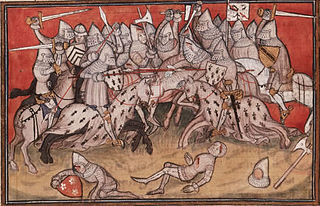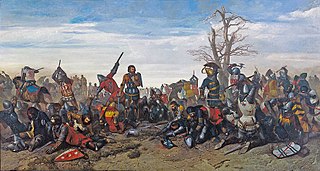 W
WThe War of the Breton Succession was a conflict between the Counts of Blois and the Montforts of Brittany for control of the Sovereign Duchy of Brittany, then a fief of the Kingdom of France. It was fought between 1341 and 12 April 1365.
 W
WThe Battle of Auray took place on 29 September 1364 at the French town of Auray. This battle was the decisive confrontation of the Breton War of Succession, a part of the Hundred Years' War.
 W
WThe Combat of the Thirty was an episode in the Breton War of Succession fought to determine who would rule the Duchy of Brittany. It was an arranged fight between selected combatants from both sides of the conflict, fought at a site midway between the Breton castles of Josselin and Ploërmel among 30 champions, knights, and squires on each side. The challenge was issued by Jean de Beaumanoir, a captain of Charles of Blois supported by King Philip VI of France, to Robert Bemborough, a captain of Jean de Montfort supported by Edward III of England.
 W
WThe Siege of Hennebont of 1342 was an episode of the succession of the War of Bretagne. The forces of Charles of Blois kept Jeanne of Flandre in the city, while they waited for English reinforcements. The arrival of these reinforcements in June 1342 provoked the lifting of the siege.
 W
WThe Battle of Morlaix was a battle fought in Morlaix on 30 September 1342 between England and France. The English besieged the town, but a French relief force arrived. The English constructed a strong defensive position. After repeated attacks, the French forced the English to retreat into the woods. The French force then withdrew. Notably it was the first use of a tactical withdrawal by the English in medieval warfare.
 W
WThe Siege of Rennes was an episode in the War of the Breton Succession during 1356-1357.
 W
WThe Battle of La Roche-Derrien was one of the battles of the Breton War of Succession; it was fought on 20th June 1347 during the night between English and French forces. Approximately 4,000–5,000 French, Breton and Genoese mercenaries laid siege to the town of La Roche-Derrien in the hope of luring Sir Thomas Dagworth, the commander of the only standing English field army in Brittany at the time, into an open pitched battle.
 W
WThe siege of Brest in 1386 was a siege by forces led by John IV, Duke of Brittany, against English-occupied Brest during the Hundred Years’ War. The siege was relieved by an English army commanded by John of Gaunt, Duke of Lancaster.
 W
WThe sieges of Vannes of 1342 were a series of four sieges of the town of Vannes that occurred throughout 1342. Two rival claimants to the Duchy of Brittany, John of Montfort and Charles of Blois, competed for Vannes throughout this civil war from 1341 to 1365. The successive sieges ruined Vannes and its surrounding countryside. Vannes was eventually sold off in a truce between England and France, signed in January 1343 in Malestroit. Saved by an appeal of Pope Clement VI, Vannes remained in the hands of its own rulers, but ultimately resided under English control from September 1343 till the end of the war in 1365.